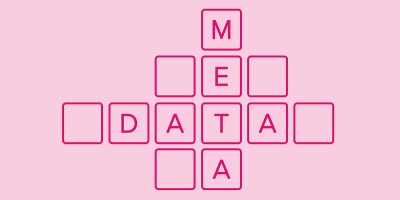
A Metadata Guide

When managing and accessing digital content, it’s essential to know what metadata is and how it works. When used intelligently, metadata makes it easier to organize, share, and use libraries of images, videos, documents, and other digital assets. This leads to workflow efficiencies, increased collaboration and productivity, and improved digital experiences on every channel.
Hundreds of brands — from NFL teams to global e-commerce companies — rely on metadata to make content findable and searchable. Metadata is a foundation of digital asset management (DAM) but its benefits reach far beyond the DAM platform itself.
This metadata guide for DAM outlines the most important things to know about what metadata is, why it matters, and how to use it strategically. Let’s start by defining metadata.
What is metadata?
| Metadata is data about data. In a DAM system, metadata is descriptive information about a piece of digital content. It’s information about a file, rather than data contained within the file itself. An asset could be a video, image, or document, and each piece of data about an asset, or metadata value, has a corresponding metadata field. A coordinated system of metadata fields is called a metadata schema. |
When a file is uploaded to a DAM system, it comes with standard information like a filename and file type. This is basic metadata. Custom metadata can also be determined and added. This curated information can include everything from the file’s status and intended use to a timestamp and digital rights information. And together, metadata provides the information needed to make digital assets findable.
What does metadata typically include?
While metadata will likely be different for each organization, the principles of collecting and organizing metadata are universal. Metadata fields are like questions, such as, “what is the color?” And the value is the answer, like, “blue.” In developing a metadata schema, some of the basic questions to answer are “what?”, “who?”, and “when?”. The more specific and standardized the answers, the easier it will be to organize a library of digital assets for easy searching, sharing, and publishing.
Here are seven questions to answer with metadata:
- What?
- When?
- Where?
- How?
- Who?
- Which?
- Why?
Identifying metadata fields, or questions, that are pertinent to each organization will help ensure that the schema is aligned with its nomenclatures and business needs.
Creating the metadata values, or answers, for each asset can be a tedious process! Fortunately, there are automation strategies that can save time and resources — and reduce human error. Simple metadata can be auto tagged using artificial intelligence (AI) tools, and software integrations across a technology stack can allow metadata to be automatically synced between systems.
Metadata examples
Everyday online experiences are built on metadata fields and values — from the search filters on retail sites to movie recommendations on Netflix. The specific values can range from “comedy” to “red” and “leather” to “chrome” depending on the product or customer experience. While every company has a unique way of defining and handling data in their DAM system based on their needs, there are many common metadata fields. Here’s a good list to start with.
- Title
- Description
- Keywords
- Product material
- Status
- File format
- Author
- Version
- Created date
- Filename
- Last updated
- Geolocation
- Usage details
If there is a way to identify or capture a piece of information about a digital asset, it can be turned into metadata. Different types of information can be used to guide internal processes and customer experiences.
Here are some common file types and related metadata typically used for each.
Images
Images have some of the most rich and complex metadata. Every time an image is produced the camera creates data about that file. The date and time the image was created, the size of the file, the file format, and the camera ID are all captured. This data can help teams understand and define internal processes and workflows.
When managing a large library of images it’s important to search, share, and distribute files efficiently. This typically relies on more detailed information to aid in finding the desired image files. Metadata fields like color, product category, license information, and other keywords are vital in organizing images for easy use. When collecting and using image data from customers, geolocation values can also be valuable.
Documents
Companies manage everything from creative briefs to contracts and payment receipts in document form. To make these easy to find, metadata is captured for everything from file type to the date created, author, and when a file was last updated. The version or “last updated” information is crucial to ensuring that global teams are working with the most recent document.
When working across global markets, language is also a common metadata field to use. Chances are documents will be created in the company’s determined language and then shared with local/regional teams to translate into other languages or dialects. Sorting documents by key data points like language, version, and category makes it much easier to find assets — especially within global organizations.
Video
Leveraging specific video-centric metadata fields in a DAM system ensures teams can quickly find, share, and publish video files. Start with video type (e.g., customer interviews, marketing, and training) to narrow the search options. Then identify fields that will allow users to filter further — for example, by which editing program was used to create the video.
Licensing, script, and language are also crucial video metadata fields that can help accelerate the search for a specific video. Teams can even include the entire video script transcript in an open-text field to allow users to search on the words and topics mentioned in a video. Company, campaign, and event-specific keywords used to describe or search for a video are also useful.
Packaging
Brands that manage digital assets to create their packaging need accurate metadata or risk costly errors, such as sending the wrong file to the printer. To prevent potentially expensive mistakes like this and to build a scalable packaging process, assets need metadata that consistently and clearly identify important packaging specifications.
Metadata to note the version, size, language, and usage details are important to ensure the right packaging is used in the right location for the right product and the right market. Having these details conveniently accessible makes sending and using the correct packaging an easier, more consistent process.
What does metadata do?
To put it simply, metadata makes everyone’s lives and jobs easier. It helps teams create content tailored to a specific audience and develop complex customer journeys and omnichannel digital experiences. When brand content has clean, meaningful metadata, teams can build new digital features faster, test products more effectively, and increase brand loyalty.
Metadata makes it easier to find the right digital assets and simplifies internal and external workflows. It also protects brand reputations from damage. With accurate data to describe assets, teams mitigate the risk of sharing old logo files, images with expired licenses, or outdated versions of documents.
How does metadata work?
Metadata is generated whenever a digital asset is created, uploaded, downloaded, or modified. It can be automatically updated or manually added. Metadata can be synced between technology platforms to ensure accuracy across tools and it can be used to permission secure access to assets. Metadata associated with digital assets is the powerful information that governs the way content is consumed and shared.
DAM and metadata
When using a DAM solution, accurate, relevant, and consistent metadata is foundational to realize the full benefits of any system. Whether retail teams are producing product content for 30,000 variants a year or agencies are managing brand assets for multiple clients, anyone working with digital content needs a well-organized system to effectively and efficiently search, share, and distribute digital assets.
Understanding the different types of metadata fields and how to use them will greatly enhance the usability and findability of digital assets.
Improving your usage of metadata
One tried and true way to improve metadata usage is to adopt controlled vocabulary lists, or CVLs. CVLs are words or phrases that are acceptable inputs for associated metadata fields. This ensures values are entered consistently — whether it’s a manual or automated process. CVLs greatly reduce opportunities for human error while keeping assets organized and easy to find via search and filter features.
Deliberate metadata management helps teams make the most of their content. To execute this properly, resources need to be devoted specifically to administering metadata. This requires a system (usually a DAM platform) and someone — or a team — to manage the schema, keep things updated, and address issues as they arise. This investment is well worth it when content is clear, organized, and can be easily used by the whole business — from marketing and sales to partners and vendors.
Interested in learning more about how a DAM solution can help your organization improve the findability and searchability of your content with metadata? See our solution in action. Request, watch, or click through a demo of Acquia DAM (Widen) today.
Note: This article was originally published on Widen.com.



